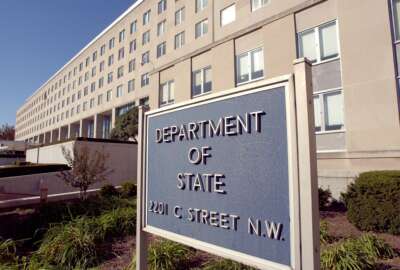As the intelligence community returns to work, employees confront new anxieties
Agencies and contractors in the intelligence community are rearranging work schedules and office spaces to prepare for the phased reentry of their employees, but...
More federal employees and contractors in the intelligence community have been gradually returning to their office spaces in the past two weeks.
But for IC leadership, “reopening” isn’t only about rearranging office spaces and cobbling together cleaning supplies and hand sanitizer, it’s also about easing the concerns of their employees and contractors who are uneasy or nervous to return to the physical workplace.
“They’ve been home for so long, and they’re trying to come back to an environment that they hadn’t been in for almost three months now,” John McDermott, an emergency management specialist at the State Department’s Bureau of Intelligence and Research (INR), said Tuesday during a webinar organized by the Intelligence and National Security Alliance.
State began bringing employees back to the office on Monday. Weeks before, INR surveyed its employees to hear more about their concerns, child care needs and other challenges during the pandemic.
INR learned it could shift two-thirds of its current, ongoing projects to employees who could more easily come into the office to work on them, McDermott said.
The bureau also found 45% of its employees rely on the Washington Metropolitan Area Transit Authority to get to work. Because of that, State has been reevaluating its parking options, McDermott said.
In addition, INR’s office directors learned 90% of their employees had some flexibility in their schedules to set alternate work hours to balance child and dependent care responsibilities and work. Those with children or high-risk family members will be the last to return to the office, McDermott said.
The National Geospatial-Intelligence Agency brought 25% of its workforce, or 2,500 employees, back into its Washington-area office last Monday. By June 29, 50% of the NGA workforce will return, said Randy Fofi, NGA’s director of installation operations.
“The biggest issue is the anxiety of the people who have been home for a couple of months now coming back in and the concerns they have,” he said. “Our commitment to them is to provide them a safe and secure workspace.”
NGA senior executives stood up an incident response team in the early days of the pandemic to set agency protocols and keep employees informed of new policies. The agency is also employing its insider threat psychologists to host one-on-one resiliency sessions with NGA employees, Fofi said.
The agency is taking employees’ temperatures once they arrive to work. It’s also posted policies and schedules for cleaning NGA facilities so employees know what to expect.
Neither State nor NGA has plans to test employees specifically for coronavirus upon entry into their facilities.
State is encouraging its employees to take their temperatures before coming to work, and it’s urging them to stay home if they feel sick at all.
“Just because you have the sniffles, everyone is going to assume,” McDermott said. “It’s going to put people in an awkward position, so we encourage that if you’re not feeling well at all to stay home.”
A few NGA employees have contracted coronavirus, Fofi said. The agency set up a “contact tracing” program that uses employee credentialing data to determine who may have been exposed and when.
“When you log on to a computer at NGA, we know who could have been near that person just by the log-on data,” he said. “We’ll go back through … to notify anyone who might have had contact.”
Intelligence community contractors readjust to office life
Federal contractors that work for the intelligence community are grappling with similar anxieties among their employees.
“It’s not just the individual stress and anxiety, but we’re starting to get a sense that the workplace is very tense for our folks in some of our customer spaces,” said Jeanine Callahan, vice president of corporate operations for Plus3 IT Systems, a small cloud services company. “There’s a lot of discussion about walking on egg shells and having to be super mindful of the level of tension that everyone is struggling with.”
Plus3 IT, which serves the defense and intelligence community, had about 20 employees who continued to work in-person for the customer agencies.
At their own corporate offices, Plus3 IT Systems spaced out desk and seating arrangements. Callahan gave her employees a video walk through of the changes that had been made in the building lobby and their own offices.
“We got really good feedback on that,” she said. “People felt very reassured that they knew what to expect, but I will say that we have really been beating the mantra of ‘you’re safer at home.’ To the extent that you do not have to come into the office, we’re encouraging folks to stay working remotely.”
At NGA, all employees will eventually return to work at the office, but the agency will continue to use telework in order to socially distance the workforce, Fofi said.
NGA “exponentially” increased telework during the pandemic for its employees, 90% of whom work with classified information or systems classified at higher levels.
“It was quite surprising,” Fofi said of the remote work experience. “We were able to continue a lot of our work through telework. There are certain things you cannot do, so those are the people who stayed in the agency, or would have to go into the agency a day or two to do things on the ‘high side.'”
The experience will serve as a launching pad for NGA to reimagine its approach to telework, the office space and parking accommodations, he added.
Beyond the challenges that come with simply reopening facilities to more people, IC agencies and contractors are also grappling with how they’ll reintegrate their teleworkers with those who have been at the office since the beginning of the pandemic.
Those who have stayed behind at State Department facilities have developed new routines and working procedures, which are jarring to employees just learning how to readjust to office life, McDermott said.
“[For] those who have been working in a workplace and have a comfortable routine, just because you’re nervous about the new folks coming into the office, they’re just as nervous coming into the office because they’ve been comfortable at home,” he said. “The idea is communicating [about] the expectations in your office when you come in. We’re promoting that [we have] one team and one effort.”
Copyright © 2025 Federal News Network. All rights reserved. This website is not intended for users located within the European Economic Area.
Nicole Ogrysko is a reporter for Federal News Network focusing on the federal workforce and federal pay and benefits.
Follow @nogryskoWFED
Related Stories





